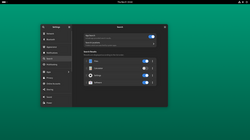Review: openSUSE MicroOS
I feel as though openSUSE's MicroOS is, at the moment, less a full featured operating system (like openSUSE Leap), Ubuntu, or Manjaro, and more of a minimal platform on which we can build our computing experience. The MicroOS edition ships with very little software, beyond the core desktop, and we (as the user) are expected to layer on any software required to accomplish tasks. While this introduces a bit more set up time at the beginning, the idea of installing just the Flatpak bundles we need does appeal to me, at least in terms of setting up an end user desktop experience.
Unlike the experience I had with MicroOS's Plasma flavour last year, the GNOME experience was quite good. I'd even say it was pleasantly polished. It feels like the developers actually use this system and have ironed out most of the issues. There were just a few exceptions, such as the GNOME Help application not displaying any documentation, but otherwise my trial with MicroOS was quite solid this time around.
When I test out distributions, especially ones trying new things, I strive to look at two key factors: Does this project accomplish what it sets out to do? And will I find this useful?

